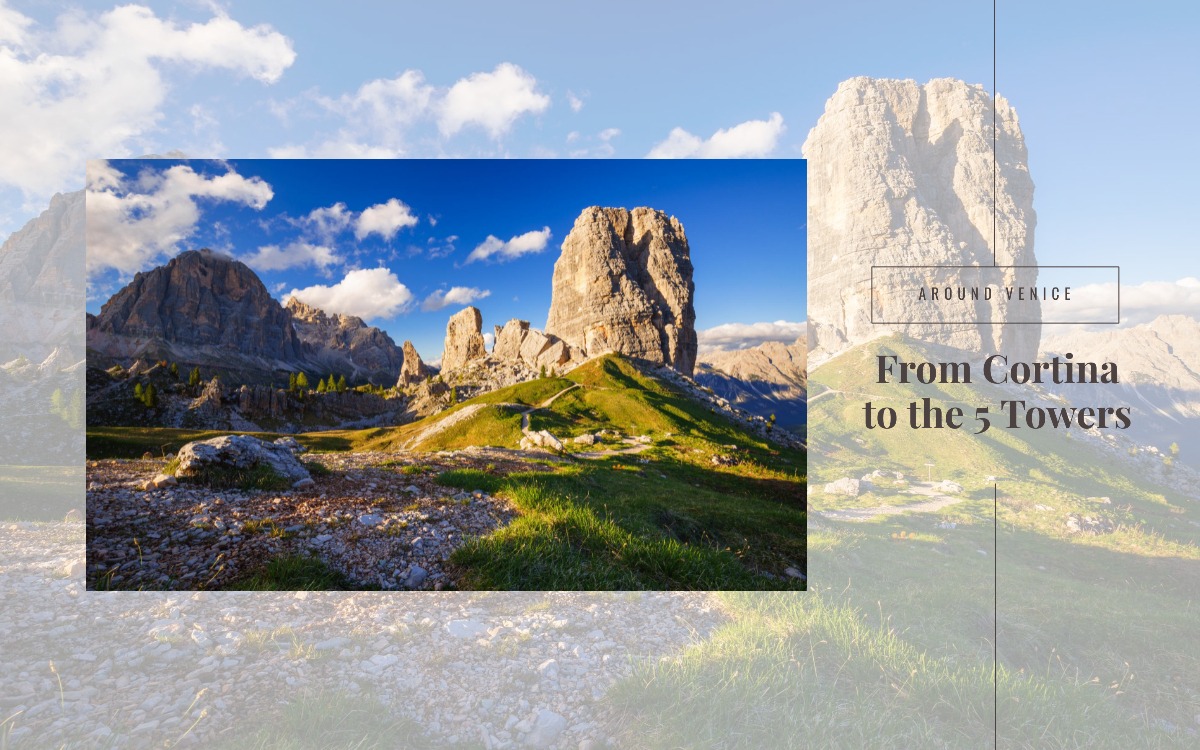The Cinque Torri, symbol of the Ampezzo Dolomites
Italy’s richness in terms of stunning landscapes, history and art is what makes this country perhaps one of the most beautiful in the world and the Dolomites are part of this immense heritage.
Declared a UNESCO World Heritage Site, they are mountain groups formed essentially by dolomite, a particular very light sedimentary rock, so much so that the Dolomites are also nicknamed the Pale Mountains.
They are located in the heart of the Eastern Alps and include legendary peaks such as Latemar, Marmolada, Monte Cristallo, Pale di San Martino and Cinque Torri, perhaps the most recognizable rock group located in the Ampezzo valley.
Cinque Torri: a travel destination for every season
The Great Tower, the Second Tower, the Third Tower, the Fourth Tower and the Fifth Tower: these are the colossal rock formations located north of Mount Avearu, between the Falzarego Pass and Cortina d’Ampezzo.
The Cinque Torri represent one of the most iconic sights of the Dolomites and it is difficult not to get excited when, at sunrise or sunset, they turn pink: this phenomenon called enrosidira, is said to be due to the curse of Laurino, the king of the dwarves who lived on Mount Catinaccio.
Legend has it that Laurin kidnapped Similde, taking her to his realm and creating a rose garden for her. The young woman’s father sent his men to save her: Laurino, wearing his invisibility belt, tried to hide in the rose garden but the movement of the roses betrayed his whereabouts. Now captured, Laurino cast a curse on his rose garden, declaring that no one would admire it anymore, by day or by night. However, he forgot about sunrise and sunset and these are the moments when all the Dolomites turn pink, including the Cinque Torri.
Those who want to get as close as possible to these rock formations of the Ampezzo Dolomites and enjoy them at sunset or at dawn, can take advantage of the many paths present, which can be followed during summer and spring and are suitable for both more experienced hikers and beginners. These routes always have good signage and their start can be reached by public transport services.
The presence of many lodges, including that of the Cinque Torri and the Scoiattoli Lodge, makes the experience even more satisfying, with the opportunity to refresh yourself with traditional cuisine and sleep right in the shadow of the Cinque Torri.
Those who organize a trip in winter can ski on the 20 km of slopes of the “Lagazuoi-5 Torri” ski area, which can be reached from both Cortina d’Ampezzo and Passo Falzarego: this ski complex is connected to the Alta Badia ski area via the Armentarola ski slope, while with the ski bus you can get to the Cortina ski area.
From the Great War Museum to Lake Bai de Dones
To get closer to the Cinque Torri and circumnavigate them, you can opt for path 439 and start from the Passo Falzarego car park until you reach the station located upstream of the Cinque Torri chairlift on foot (the alternative is to use the chairlift itself).
As previously mentioned, at the foot of the five Ampezzo rock formations there are many lodges that make any excursion more comfortable. The Scoiattoli Lodge is located near the slopes of the “Dolomiti Superski” area and also offers its patrons the opportunity to bathe in pine wood tubs with hot water, even in the middle of winter when the surrounding landscape is all covered in snow.
The Cinque Torri Lodge dates back to 1904 and, throughout its history, it has hosted even King Vittorio Emanuele II who, during the Great War, went there to witness the explosion of the famous Mina del Castelletto.
From the latter you can also reach the Via Ferrata dell’Averau which offers hikers a 360° view of the peaks of Sorapiss, Monte Pelmo, Antelao and Monte Civetta.
The two lodges are located a stone’s throw from the moving Museum of the Great War, a vast area where Italians and Austro-Hungarians fought fierce battles: this place was occupied by Italian soldiers while in the area in front of the Lagazuoi-Forte Tre Sassi were the Austrians. This open-air museum allows everyone to experience the atrocities of war first-hand, visiting the firing positions, the barracks, the infirmary and the trenches, complete with period objects, mannequins wearing authentic uniforms and exhaustive illustrative panels .
A little further north of the museum and a stone’s throw from the Cinque Torri chairlift, you can see the Baita Bai de Dones, near which there is a small lake where, according to an ancient Ladin legend, the mythological Anguànesnymphs with goat’s feet live: it is said that these waters are benevolent and that they help women who bathe in them to have children.




